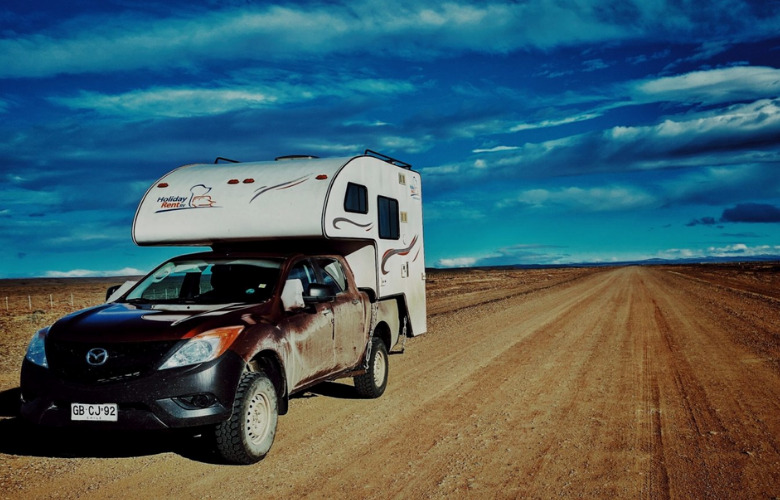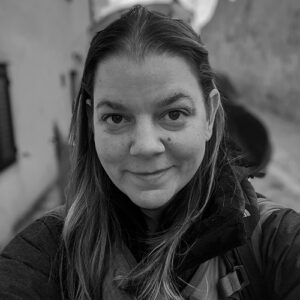
After our first night of wind and foxes, we woke up to an incredible view of Torres Del Paines but unfortunately our luck with the weather would come to a quick end. We made some breakfast and coffee then packed up the camper and got on the road. The day was grey and windy but we got some good glimpses of the mountains as the clouds rolled in and out.
We decided to drive the Y-290 and Y-150 which create a loop of the park, since it was July we saw basically no one all day. It was strange and amazing to feel like we had all of the national park to ourselves. We spent some time at the various glacial lakes and overlooks, we stopped for a bit on the shore of Lago Grey, a glacial lake that has a black sand beach. The lake gets its name from the glacier that forms it. Grey Glacier is one of the many glaciers in the southern ice field, it is 6km (3.7 miles) wide and approximately 30km (18.6 miles) high. The bright blue chunks of ice that have broken off the front of the glacier look like colorful misshapen boats floating in a sea of grey.
The landscape in Patagonia is truly amazing, it’s no wonder it is referred to as one of the premier adventure destinations in the world. As the sun began to set we made our way toward El Calafate, a three-hour drive with our first border crossing. The Chile border was really easy, we just went in, got our stamps, and crossed. When we arrived at the Argentina Border it was a small building and luckily we arrived when we did because they were closing for the evening. After the camper inspection, the border agent told us that there was a shortcut to get back to the highway and that he was headed home so we could follow him. It’s good that we did because the roads are unmarked dirt paths that have no lights whatsoever, we might still be driving aimlessly in Southern Argentina.
The next morning we started the day by wandering around the downtown of El Calafate, like Torres Del Paine, there were not so many tourists at this time of the year, which meant that not all the shops were open. After a bit of sightseeing and breakfast, we got back on the road and headed for the Perito Moreno Glacier. The Perito Moreno Glacier is a 250 km2 (97 sq mi) ice formation, 30 km (19 mi) in length, and is one of the most popular tourist destinations in Southern Argentina. You can book a tour to go trekking on the glacier from the town of El Calafate. This would be my second trip to the glacier, the first time I did the trekking adventure, fun fact there is a bottle of scotch waiting for you on that trek, but this time we would only visit the viewing platforms and surrounding areas.
One interesting thing about the Perito Moreno Glacier is that unlike most glaciers that are retreating due to global warming, the Perito Moreno glacier is growing and advancing. It also has regular ruptures that draw huge crowds, as the glacier advances it dams the southern side of Lago Argentino. This separated body of water is known as Brazo Rico, eventually, the water pressure builds up against the Glacier and a large eruption happens. When we visited the glacier there was no ice dam, so no eruption for us. If you have the chance to visit Perito Moreno you must go to the viewing platforms to get the top view of the glacier, it is truly huge. We hung around watching and listening to the glacier crack and creak while we had some lunch in the sun before getting on the road again. This time we were headed to another famous destination El Chaltén, a small town at the base of Cerro Torre and Mount Fitz Roy.
We arrived at the town of El Chaltén around dusk and headed to the base of Fitz Roy to camp for the night. According to Google maps, there were quite a few camping sites and hostels available, so we passed through town and drove out into the wilderness. The road was gravel and in disrepair, but we carried on, soon we arrived at the first camping area, it was closed. The further we drove the worse the road became, and the more closed campgrounds we found. At some point, we passed a place that I now know is called Bonanza Eco Adventure, but that night in the dark it looked like a post-apocalyptic zombie hangout. From the truck, we could see in the windows and everything looked as if the inhabitants had left in a hurry, the refrigerator was wide open and there was a teddy bear and toys on the table. Creepy.
In all fairness we were traveling at the wrong time of the year, it’s perfectly normal to leave the refrigerator open when it is unplugged, and I’m sure those people are well and have not been eaten by zombies. After that I was a bit freaked out, the mind tends to wander when you are driving alone in the middle of nowhere in the dark. So we decided to head back toward the town to see if there was a well-lit zombie-free place we could park for the night. The first place we saw open with a parking lot was a bar, it seemed like a sign so we went in to have a beer and ask about parking.
Since there was wifi in the bar we decided to take the opportunity to look at the next few days of the trip, after all, we had to be in Santiago in 6 days. Looking at the map we realized that the ferry that we needed to take in a few days wasn’t running every day because it was the offseason. The winter ferry schedule now meant that we had to be in Chaitén, Chile in about 60 hours to catch the ferry, which according to Google was 1,498 km (931 miles). Sh!t! We began chatting with the bartender, she, like everyone else, wanted to know what we were traveling now and where we were going. We explained that we were planning to hike to the Eagle lookout in the morning and then carry on making our way to Santiago but we just realized our mistake with the ferry schedule so now we were going to have to get up at sunrise and drive nonstop for the next 2 days.
There was a man sitting at the bar next to us and he gave us even more insight into our mistake, Highway 40, the road we needed to take the next day was 500km (310 miles) of compressed clay. He said that at this time of year it is often impassable because the rain turns the road into deep clay mud, so we needed to get to the town of Tres Lagos and wait for someone to come from the opposite direction on Hwy 40 and ask them about the conditions to see if it was passable. If the road wasn’t accessible we would have to drive across the width of Argentina and come up the coast adding +600km to our trip.
In addition to that news, we found out that we needed to cross the border back to Chile the next evening because the border doesn’t open till 8 am and the first ferry we needed to take also departed at 8 am. We couldn’t believe how close we had been to really screwing up this trip. We thanked the man and chatted a bit more about Hwy 40, trying to understand how a national highway could be so bad. We vowed to get up with the sun and start driving since we had 700km (435 miles) to get to the border. The man had one more valuable piece of information, he said that we had to fill the truck with gas at the gas station in El Chaltén because there would not be another one for 300km. So, on top of all of that, we couldn’t start driving till 10 am because that is when the gas station opened. Like I said before, the best decision of the trip was to walk into that bar!
At 9:30 the next morning we were sitting at the gas station waiting. At 10:15 the attendant showed up and we filled the truck to the brim. We set out for Tres Lagos, in just under 3 hours we would find out if we could continue our journey or if we needed to start finding an alternate plan to get back to work on time. We arrived in Tres Lagos and it was a ghost town, there was no one around. We parked near the intersection of Hwy 40 and waited. Luckily we only had to wait about 20 minutes before we saw a tanker truck leaving the 40, we waved him down and asked about the conditions. He said that the road was dry and pretty compacted, Woohoo!
With a renewed sense of hope, we began our adventure on the 40. It didn’t take long for the excitement to wear off, the highway is literally just dirt. There is nothing around at all, just a dirt road flanked by fences. Every now and then we would pass another car, but it was pretty rare. The only other forms of life we saw were herds of Guanacos, a llama-like animal that roams in the south-central part of Argentina and Chile. The fences are meant to keep them out of the roadway but it doesn’t work very well, sometimes the Guanacos even get stuck on the fence as they are trying to jump over sadly leaving an impaled Guanaco hanging on the fenceline.
The good news is that you can see for miles and there are practically no curves in this section of Hwy 40. Cris took this boring road as an opportunity to test out the max speed of the truck a few times, turns out that the road also doubled as a dirt race track. After hours and hours of dirt, we started to see snow again on the sides of the road, we got an amazing sunset as we continued making our way to the border. Eleven and a half hours after we had gotten on the road we made it to the border, with 30 minutes to spare before they closed! We made it out of Argentina and back into Chile! We were exhausted and quickly found a place to park and sleep.
Published in Collaboration with Next Stop Awesome

#RedAlertRESTART and #WeMakeEvents


Emily Meyer is a seasoned Production Manager and has been working in the entertainment industry for the last 20 years. She began her career working in a small community theater in Kentucky and has subsequently worked for names like Barbara Streisand, AVICII, and Cirque Du Soleil. After completing the creation of 绮幻之境 -The Land of Fantasy in Hangzhou, China, Emily moved to Berlin, Germany where she is currently a Freelance Project and Marketing Manager. Since the onset of COVID, she spends most of her free time cooking, working on her blog Next Stop Awesome, and planning for the next travel adventures.
Read Full Profile© 2021 TheatreArtLife. All rights reserved.

Thank you so much for reading, but you have now reached your free article limit for this month.
Our contributors are currently writing more articles for you to enjoy.
To keep reading, all you have to do is become a subscriber and then you can read unlimited articles anytime.
Your investment will help us continue to ignite connections across the globe in live entertainment and build this community for industry professionals.